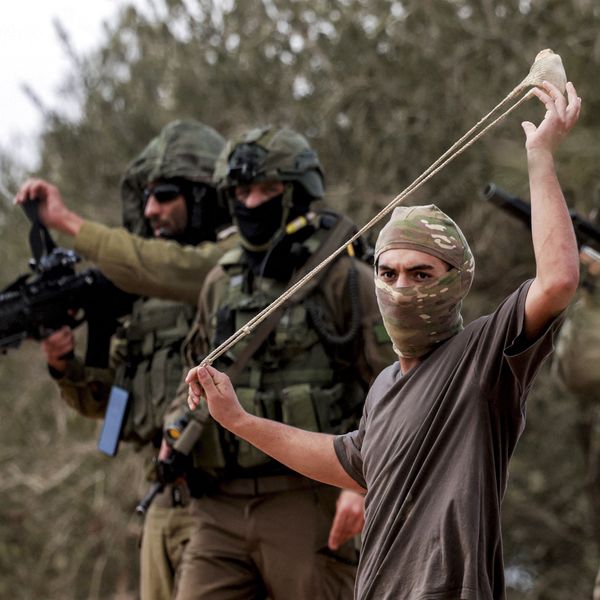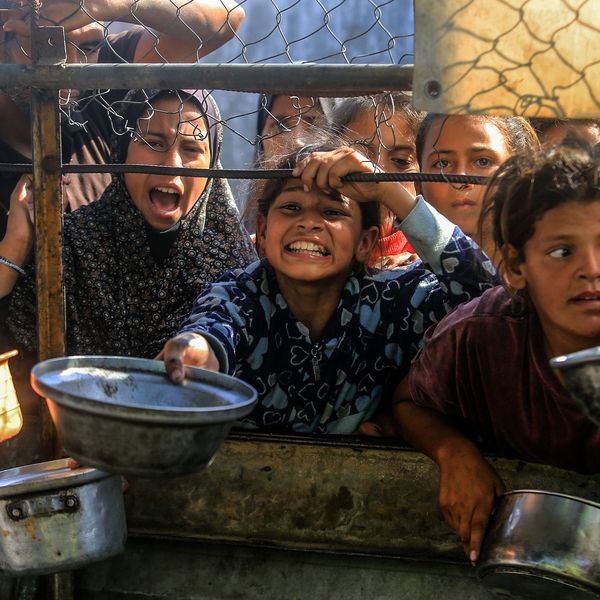Ethnic Cleansing in the Israeli Negev
The razing of a Bedouin village by Israeli police shows how far the state will go to achieve its aim of Judaising the Negev region
A menacing convoy of bulldozers was heading back to Be'er Sheva as I
drove towards al-Arakib, a Bedouin village located not more than 10
minutes from the city. Once I entered the dirt road leading to the
village I saw scores of vans with heavily armed policemen getting ready
to leave. Their mission, it seems, had been accomplished.
The
signs of destruction were immediately evident. I first noticed the
chickens and geese running loose near a bulldozed house, and then saw
another house and then another one, all of them in rubble. A few
children were trying to find a shaded spot to hide from the scorching
desert sun, while behind them a stream of black smoke rose from the
burning hay. The sheep, goats and the cattle were nowhere to be seen -
perhaps because the police had confiscated them.
Scores of
Bedouin men were standing on a yellow hill, sharing their experiences
from the early morning hours, while all around them uprooted olive trees
lay on the ground. A whole village comprising between 40 and 45 houses
had been completely razed in less than three hours.
I
suddenly experienced deja vu: an image of myself walking in the rubbles
of a destroyed village somewhere on the outskirts of the Lebanese city
of Sidon emerged. It was over 25 years ago, during my service in the
Israeli paratroopers. But in Lebanon the residents had all fled long
before my platoon came, and we simply walked in the debris. There was
something surreal about the experience, which prevented me from fully
understanding its significance for several years. At the time, it felt
like I was walking on the moon.
This time the impact of the
destruction sank in immediately. Perhaps because the 300 people who
resided in al-Arakib, including their children, were sitting in the
rubble when I arrived, and their anguish was evident; or perhaps because
the village is located only 10 minutes from my home in Be'er Sheva and I
drive past it every time I go to Tel Aviv or Jerusalem; or perhaps
because the Bedouins are Israeli citizens, and I suddenly understood how
far the state is ready to go to accomplish its objective of Judaising
the Negev region; what I witnessed was, after all, an act of ethnic cleansing.
They
say the next intifada will be the Bedouin intifada. There are 155,000
Bedouins in the Negev, and more than half of them live in unrecognised villages
without electricity or running water. I do not know what they might do,
but by making 300 people homeless, 200 of them children, Israel is
surely sowing dragon's teeth for the future.
An Urgent Message From Our Co-Founder
Dear Common Dreams reader, The U.S. is on a fast track to authoritarianism like nothing I've ever seen. Meanwhile, corporate news outlets are utterly capitulating to Trump, twisting their coverage to avoid drawing his ire while lining up to stuff cash in his pockets. That's why I believe that Common Dreams is doing the best and most consequential reporting that we've ever done. Our small but mighty team is a progressive reporting powerhouse, covering the news every day that the corporate media never will. Our mission has always been simple: To inform. To inspire. And to ignite change for the common good. Now here's the key piece that I want all our readers to understand: None of this would be possible without your financial support. That's not just some fundraising cliche. It's the absolute and literal truth. We don't accept corporate advertising and never will. We don't have a paywall because we don't think people should be blocked from critical news based on their ability to pay. Everything we do is funded by the donations of readers like you. Will you donate now to help power the nonprofit, independent reporting of Common Dreams? Thank you for being a vital member of our community. Together, we can keep independent journalism alive when it’s needed most. - Craig Brown, Co-founder |
A menacing convoy of bulldozers was heading back to Be'er Sheva as I
drove towards al-Arakib, a Bedouin village located not more than 10
minutes from the city. Once I entered the dirt road leading to the
village I saw scores of vans with heavily armed policemen getting ready
to leave. Their mission, it seems, had been accomplished.
The
signs of destruction were immediately evident. I first noticed the
chickens and geese running loose near a bulldozed house, and then saw
another house and then another one, all of them in rubble. A few
children were trying to find a shaded spot to hide from the scorching
desert sun, while behind them a stream of black smoke rose from the
burning hay. The sheep, goats and the cattle were nowhere to be seen -
perhaps because the police had confiscated them.
Scores of
Bedouin men were standing on a yellow hill, sharing their experiences
from the early morning hours, while all around them uprooted olive trees
lay on the ground. A whole village comprising between 40 and 45 houses
had been completely razed in less than three hours.
I
suddenly experienced deja vu: an image of myself walking in the rubbles
of a destroyed village somewhere on the outskirts of the Lebanese city
of Sidon emerged. It was over 25 years ago, during my service in the
Israeli paratroopers. But in Lebanon the residents had all fled long
before my platoon came, and we simply walked in the debris. There was
something surreal about the experience, which prevented me from fully
understanding its significance for several years. At the time, it felt
like I was walking on the moon.
This time the impact of the
destruction sank in immediately. Perhaps because the 300 people who
resided in al-Arakib, including their children, were sitting in the
rubble when I arrived, and their anguish was evident; or perhaps because
the village is located only 10 minutes from my home in Be'er Sheva and I
drive past it every time I go to Tel Aviv or Jerusalem; or perhaps
because the Bedouins are Israeli citizens, and I suddenly understood how
far the state is ready to go to accomplish its objective of Judaising
the Negev region; what I witnessed was, after all, an act of ethnic cleansing.
They
say the next intifada will be the Bedouin intifada. There are 155,000
Bedouins in the Negev, and more than half of them live in unrecognised villages
without electricity or running water. I do not know what they might do,
but by making 300 people homeless, 200 of them children, Israel is
surely sowing dragon's teeth for the future.
A menacing convoy of bulldozers was heading back to Be'er Sheva as I
drove towards al-Arakib, a Bedouin village located not more than 10
minutes from the city. Once I entered the dirt road leading to the
village I saw scores of vans with heavily armed policemen getting ready
to leave. Their mission, it seems, had been accomplished.
The
signs of destruction were immediately evident. I first noticed the
chickens and geese running loose near a bulldozed house, and then saw
another house and then another one, all of them in rubble. A few
children were trying to find a shaded spot to hide from the scorching
desert sun, while behind them a stream of black smoke rose from the
burning hay. The sheep, goats and the cattle were nowhere to be seen -
perhaps because the police had confiscated them.
Scores of
Bedouin men were standing on a yellow hill, sharing their experiences
from the early morning hours, while all around them uprooted olive trees
lay on the ground. A whole village comprising between 40 and 45 houses
had been completely razed in less than three hours.
I
suddenly experienced deja vu: an image of myself walking in the rubbles
of a destroyed village somewhere on the outskirts of the Lebanese city
of Sidon emerged. It was over 25 years ago, during my service in the
Israeli paratroopers. But in Lebanon the residents had all fled long
before my platoon came, and we simply walked in the debris. There was
something surreal about the experience, which prevented me from fully
understanding its significance for several years. At the time, it felt
like I was walking on the moon.
This time the impact of the
destruction sank in immediately. Perhaps because the 300 people who
resided in al-Arakib, including their children, were sitting in the
rubble when I arrived, and their anguish was evident; or perhaps because
the village is located only 10 minutes from my home in Be'er Sheva and I
drive past it every time I go to Tel Aviv or Jerusalem; or perhaps
because the Bedouins are Israeli citizens, and I suddenly understood how
far the state is ready to go to accomplish its objective of Judaising
the Negev region; what I witnessed was, after all, an act of ethnic cleansing.
They
say the next intifada will be the Bedouin intifada. There are 155,000
Bedouins in the Negev, and more than half of them live in unrecognised villages
without electricity or running water. I do not know what they might do,
but by making 300 people homeless, 200 of them children, Israel is
surely sowing dragon's teeth for the future.

